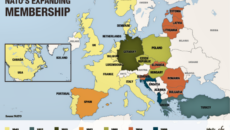In just a few, short days, the European countries have been treated like weaklings twice. The first time was by U.S. Secretary of Defense Robert Gates, who said, “The mightiest military alliance in history [NATO, Ed.] is only eleven weeks into an operation against a poorly armed regime in a sparsely populated country [Libya, Ed.] yet many allies are beginning to run short of munitions, requiring the US, once more, to make up the difference.” Then, right after that, came a statement by Anders Fogh Rasmussen, Secretary General of NATO, who stated that the Libya operation highlighted the dependency on U.S. surveillance, intelligence equipment and precision weapons.
One can be a pacifist and against armies or even a non-pacifist but against the war in Libya. However, one fact remains: North Africa (Libya included) has a very high strategic interest in Europe, and in any case there is a war and it’s at our door, just across the sea. If Europe doesn’t mobilize in these conditions, when will it ever be willing to, know how to or be able to mobilize? Is it acceptable that an international military mission without high intensity is already short of breath? (The one in Kosovo in 1999 was far more massive, and in any case this isn’t a question of sending thousands of men to a distant front like Afghanistan.)
Once again, the cold, hard facts emerge: Europe is in NATO, convinced that NATO is “an American thing” and therefore that America will take care of matters sooner or later. Even when it’s a question of something in our own back yard, like the Balkans in the ’90s or the Maghreb over the last few months. Just look at the figures: NATO asks its members to spend at least 2% of their GDP on defense. The U.S. spends 5% but among the European countries only four reach or exceed 2%: France, Great Britain, Bulgaria and—paradoxically, given its financial crisis—Greece (3.3%). In 2010, Italy was at around 1.8%. The European average is at roughly 1.6%, and bringing up the rear in terms of spending are Austria (0.94%), Ireland (0.58%) and Malta (0.50%).
The problem is that in the U.S., international military commitment—especially when it isn’t aimed at protecting or promoting American interests—is being viewed with greater and greater skepticism, as shown by the difficulty Barack Obama has encountered in obtaining new financing for missions, Libya included. And that’s not all: the political class that lived through and fought in the Cold War is about to leave the scene, the class that still sees NATO and its commitments as a means of safeguarding the West. Tomorrow, the U.S. might be governed by politicians who are far more concerned, for example, with containing China in Asia than it is in getting Gaddafi (or Assad, seeing how things are going) out of North Africa. And what would Europe do then?
As is true for many other problems (from immigration to economic crises), the answer, perhaps, isn’t “fewer armies” but “more Europe”. More integration and more collaboration, even in the military field, to reduce spending and grow the continental technology industry. Europe produces 21 different kinds of armored vehicles, six different submarine models and three fighter bombers, not to mention weaponry systems, cargo planes and non-armored military vehicles. What are they for? Who are they for? Wouldn’t it be easier to imagine having a single kind of bomber or tank for everyone rather than dreaming of an army for everyone? France and Great Britain, historic rivals, set a fine example: in 2010 they signed a military collaboration agreement providing for joint efforts in nuclear testing, aircraft carriers and engineering. Here more than anywhere else, there is safety to be found in living in a perfect union.




Hey how are you doing? I just wanted to stop by and say that it’s been a pleasure reading your blog. I have bookmarked your website so that I can come back & read more in the future as well. plz do keep up the quality writing
Very interesting ideas! I’ll be back for your new articles!
It’s arduous to find educated individuals on this topic, however you sound like you understand what you’re speaking about! Thanks